AI中的搜索算法
本文主要整理下AI中最常用搜索算法, 包括BFS, A*

本文的图就是用这个开源项目生成的
BFS
伪代码
//引入一个集合,用来保存已经走过的路口
closed = {}
q = newqueue
q.enqueue(newpath(start))
while q is not empty
p = q.dequeue
//如果下面closed集合中包含了路径p的最后一个路口
//p.last则忽略
if closed contains p.last
continue
//如果路径p的最后一个路口即是目的地,则直接返回p
if p.last == destination
return p
//否则将该点p.last加入到closed集合中
closed.add(p.last)
//把点p.last相邻的点加入到队列中
foreach n in p.last.neighbours
q.enqueue(p.continuepath(n))
//找不到合适的路
return null
A*
相比BFS, 相当于队列需要考虑该状态离出发点和到终点的一个目标函数, 认为这个目标函数越高, 就优先从队列中推出, 由于不知道离终点多远, 一般近似用曼哈顿距离.
伪代码如下
//引入一个集合,用来保存已经走过的路口
closed = {}
q = newqueue;
//q为优先队列,记录路径的消耗以及路径,起始点消耗为0
q.enqueue(0, newpath(start))
while q is not empty
//优先队列弹出消耗最小的路径
p = q.dequeueCheapest
if closed contains p.last
continue;
if p.last == destination
return p
closed.add(p.last)
foreach n in p.last.neighbours
//获得新的路径
newpath2 = p.continuepath(n)
//将新路径的总消耗(G+H),和新路径分别入队
q.enqueue(newpath.G + estimateCost(n, destination), newpath2)
return null
这里估计可以用曼哈顿距离(所以是启发式算法)
将A*具体应用, 可以用到贪吃蛇, 8-puzzle问题.
具体可以用BFS, DDFS, A*(不同的启发算法可以由不同的结果, 一般用曼哈顿距离).
Reference
AI for 8 puzzles对该问题的求解
Minmax with Alpha Beta Pruning
所谓minmax, 包含两个步骤, 当我们构建好了目标函数(比如下棋问题, 赢了就算+10分, 输了就算-10分), 对我们自己来说肯定是选择使得目标函数最大的步骤, 这就是max步骤.但是当你下完了之后, 对手会朝着使得同一目标函数最小的方向走(也就是和你相反的反向), 这就是min步骤. 实际上可以看到是递归穷举的, 可以引入alpha-beta剪枝来减少计算量.
def minmax(board, depth):
global choice
result = check_win_game(board)
if result != CONT_GAME:
return unit_score(result, depth)
depth += 1
scores = []
steps = []
for step in get_available_step(board):
score = minmax(update_state(board,step,depth),depth)
scores.append(score)
steps.append(step)
if depth % 2 == 1:
max_value_index = scores.index(max(scores))
choice = steps[max_value_index]
return max(scores)
else:
min_value_index = scores.index(min(scores))
choice = steps[min_value_index]
return min(scores)
上面就是算法核心, max自己得分, min对方得分.
Reference
Tic tac toe
Minimax with Alpha Beta Pruning
Q learning
Reference
Pypix: Reinforcement Learning With Python
Reference
单元测试
使用
python 的 unittest
可以试试